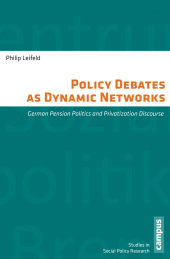 Neuerscheinungen 2016Stand: 2020-02-01 |
Schnellsuche
ISBN/Stichwort/Autor
|
Herderstraße 10
10625 Berlin
Tel.: 030 315 714 16
Fax 030 315 714 14
info@buchspektrum.de |

Philip Leifeld
Policy Debates as Dynamic Networks
German Pension Politics and Privatization Discourse. Dissertationsschrift
2016. 360 S. w. figs. 213 mm
Verlag/Jahr: CAMPUS VERLAG 2016
ISBN: 3-593-50570-3 (3593505703)
Neue ISBN: 978-3-593-50570-1 (9783593505701)
Preis und Lieferzeit: Bitte klicken
Schriften des Zentrums für Sozialpolitik, Bremen
Wie funktionieren politische Debatten? Welchen Einfluss können Politiker und Interessengruppen über die Medien auf politische Prozesse nehmen? Philip Leifeld stellt die Diskursnetzwerkanalyse als Werkzeugkasten für die Analyse politischer Debatten vor und wendet die Methoden auf die deutsche Rentenpolitik der 1990er Jahre an. Schritt für Schritt zeichnet er die Entstehung und die Auflösung von inhaltlichen Koalitionen und Polarisierungen im politischen Diskurs nach und liefert so einen Erklärungsansatz für die "Riester-Reform", die einen radikalen Bruch mit der bis dahin verfolgten Politik darstellte.
Contents
Prefacexi
I.The Theory and Methodology of Discourse Networks
1.Introduction3
2.Actor-centered approaches to discourse7
2.1.The Advocacy Coalition Framework9
2.2.Veto player analysis16
2.3.Punctuated Equilibrium Theory17
2.4.Policy paradigms and social learning21
2.5.Collective symbolic coping23
2.6.Civic arenas25
2.7.Multiple streams26
2.8.Argumentative discourse analysis and discourse coalitions .28
2.9.Epistemic communities30
2.10.Comparison of actor-centered approaches32
3.Content-oriented approaches to discourse37
3.1.Critical discourse analysis38
3.2.Category-based content analysis40
3.3.Frame mapping and the co-occurrence approach41
3.4.Clause- or grammar-based methods and knowledge graphs .43
3.5. Semantic networks45
3.6. Comparison of content-oriented approaches48
4.Hybrid approaches: linking actors and contents53
4.1.Decomposition analysis53
4.2.Political claims analysis54
4.3.Conclusions for a new discourse methodology57
4.4.Policy network analysis60
5.The methodology of discourse network analysis61
5.1.Coding procedure61
5.2.Affiliation networks62
5.3.Actor congruence networks64
5.4.Concept congruence networks69
5.5.Conflict networks71
5.6.Time window networks72
5.7.Attenuation networks78
5.8.Software implementation84
5.8.1.Encoding statements84
5.8.2.Network export facilities86
II. A Showcase: German Pension Politics, 1993-2001
6.German pension politics in the 1990s and the 2001 Riester reform91
6.1.Dimensions of pension systems and the status quo in the 1990s 93
6.1.1.Pay-as-you-go versus capital cover systems93
6.1.2.Public versus private pension systems97
6.1.3.Voluntary versus mandatory contributions98
6.1.4.Intra-generative redistribution versus equivalence .98
6.1.5.Risk balance 101
6.1.6.The pension formula102
6.2.Demographic change and the pension gap104
6.2.1.Demographic Transition as a complex long-term risk 105
6.2.2.Mortality106
6.2.3.Fertility107
6.2.4.Inconsistent solution concepts in the demographic debate110
6.2.5.Migration111
6.3.The 2001 Riester reform112
6.3.1.The 1999 Pension Reform Act112
6.3.2.Changes in the 2001 reform113
6.4.Positive analyses of the policy outcome117
7.Description of the dataset and univariate analysis . . . . .125
7.1. Coding procedure . . . . . . . . . . . . . . . . . .....125
7.2. Media bias and validity . . . . . . . . . . . . . . . .....128
7.2.1.Record coding . . . . . . . . . . . . . . . .....129
7.2.2.Data coding . . . . . . . . . . . . . . . . .....133
7.2.3.Indexing . . . . . . . . . . . . . . . . . . .....134
7.3. Actors in the pension discourse . . . . . . . . . . .....134
7.3.1.Government . . . . . . . . . . . . . . . . .....135
7.3.2.Social actors . . . . . . . . . . . . . . . . .....136
7.3.3.Liberal actors . . . . . . . . . . . . . . . .....136
7.3.4.Financial sector . . . . . . . . . . . . . . .....137
7.3.5.Young actors . . . . . . . . . . . . . . . . .....137
7.3.6.Scientists . . . . . . . . . . . . . . . . . . .....137
7.3.7.Other actors . . . . . . . . . . . . . . . . .....137
7.4. Univariate analysis: concepts in the pension discourse..138
7.4.1.System change . . . . . . . . . . . . . . . .....140
7.4.2.Retrenchment within the PAYG paradigm .....151
7.4.3.Strengthening the insurance principle . . . .....160
7.4.4.Increasing the number of contributors . . .....167
8.Empirical analysis of the German pension discourse in the 1990s183
8.1.Discourse activity over time184
8.2.Cross-sectional actor congruence, 1993-2001188
8.3.Longitudinal change199
8.4.Analysis of political parties209
8.5.Identification of ideologies214
8.6.Discussion and conclusion218
III. Models of Discursive Behavior
9.The contagious dimension of political discourse225
9.1.Attention and interaction in media discourse225
9.1.1.Dis


